A Guide to Facebook Ads Objectives
Posted on 11/3/2023
Reviewed by Arnt Eriksen updated at 11/7/2023
Introduction
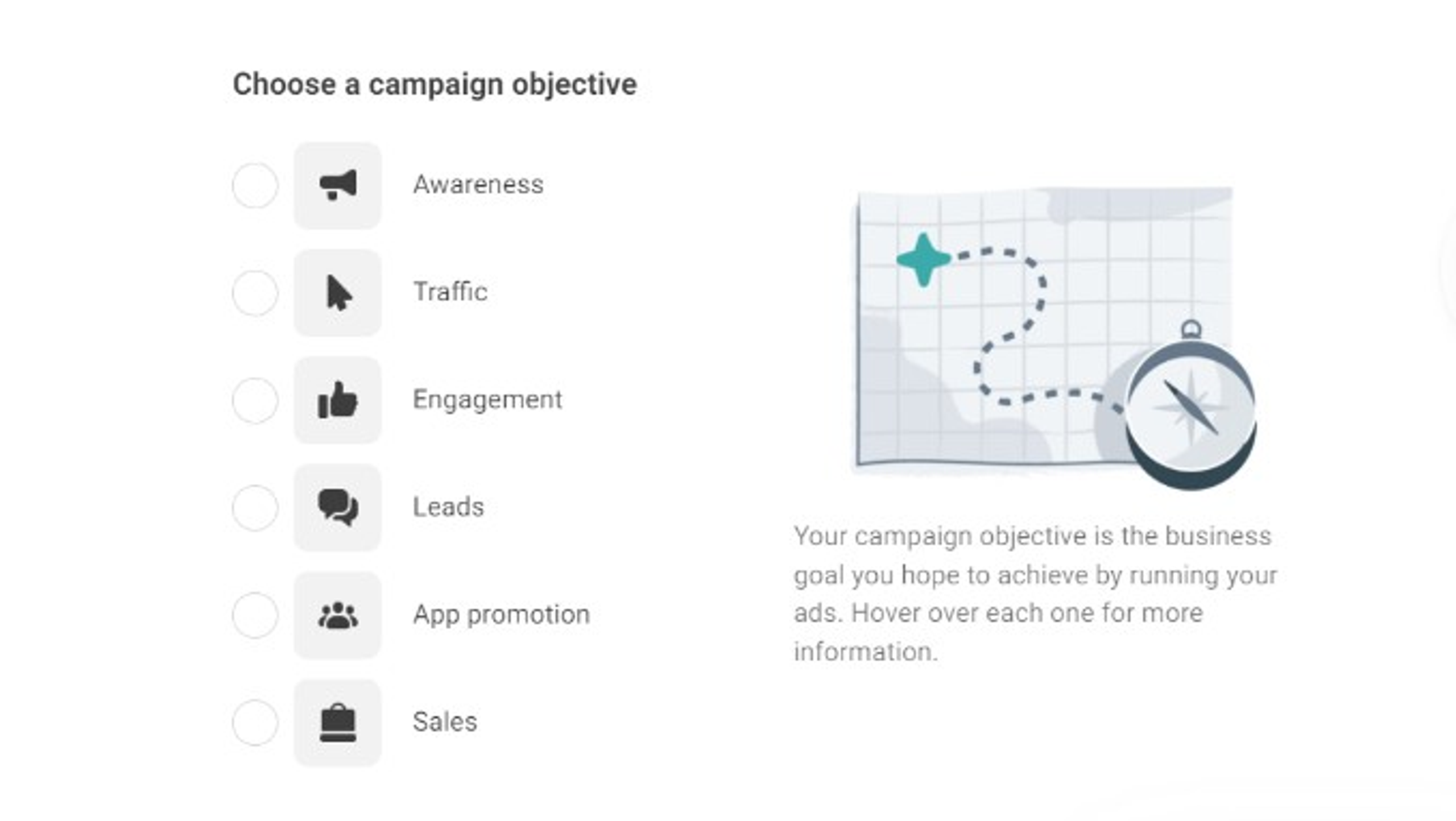
Facebook can't read your mind. To make its ads do what you want them to do, you need to understand how Facebook Ads objectives work.
With 2.6 billion users on the platform, Facebook records a revenue of about 17.4 billion dollars in three months on just advertising!
When you break that number down, you realize that advertisers spend at least six dollars to advertise to each Facebook user.
It doesn't take a genius to figure out that Facebook earns a lot from Facebook Ads. But the important question is this:
What do you earn from advertising?
To a very large extent, the profit you earn is determined by the performance of your Facebook ad.
Does it reach the target audience? Does it achieve the campaign objectives that you set for it? The answers to these questions determine how successful your ads will be.
Unfortunately, not every effort that people make with Facebook advertising pays off. The primary reason is that most people do not set the right campaign objectives or fail to reach the right target audience.
Facebook ad campaigns allow you to set an objective that you want each Facebook ad to achieve. In this article, we will be discussing the Facebook campaign objectives and the best ways to use them.
What Is a Facebook Campaign Objective?
In the literal sense, a Facebook campaign objective refers to the action you would like your target audience to take after engaging your ad. This would mostly determine the kind of audience that gets to see your brand.
In the Facebook context, A Facebook ad objective tells Facebook what you want people to do after seeing your ad. This goal then helps Facebook determine the right target audience that would most likely carry out the action you desire.
In most cases, Facebook does not have difficulty finding the right target audience for your ad campaign. This is because users constantly indicate their interests, likes, and inclinations on the platform.
The Facebook algorithm then takes this information and analyzes it to know which ads are most appropriate to show to which client and what kind of actions they would take after viewing the ad.
When you set the wrong objectives, Facebook tends to show your ads to people who would most likely take that action.
For instance, you run a start-up company which you have run an ad campaign for. While creating the ad, you set the campaign objective to create awareness when you actually need to make sales. Facebook is now more likely to direct your ad to people who will not make a purchase because you have requested to only create awareness.
There is another mistake that businesses often make in Facebook Advertising. When setting up their campaign, they tend to pick more than two Facebook ad campaign objectives. When you do this, Facebook has the option to choose between the two target audiences.
The 11 Facebook Ad Campaign Objectives and How to Choose What’s Right For Your Business

Not so long ago, Facebook merged the eleven campaigns into three objectives with sub-objectives under them. In this article, we will take a look at all these objectives.

How to Set the Right Campaign Objective
To select the right campaign objective, you must determine what you plan to achieve with this ad.
Are you a new brand and you want people to get to know you?
Do you have many competitors but you want your audience to consider you?
Are you trying to increase your sales and conversions?
When you answer specific questions like this, you can look for the Facebook campaign objective that aligns the most with your goals and use it. Each Facebook ad objective has a little description and guideline when you click on it. This gives you details about the campaign objective and when it's best to use it.
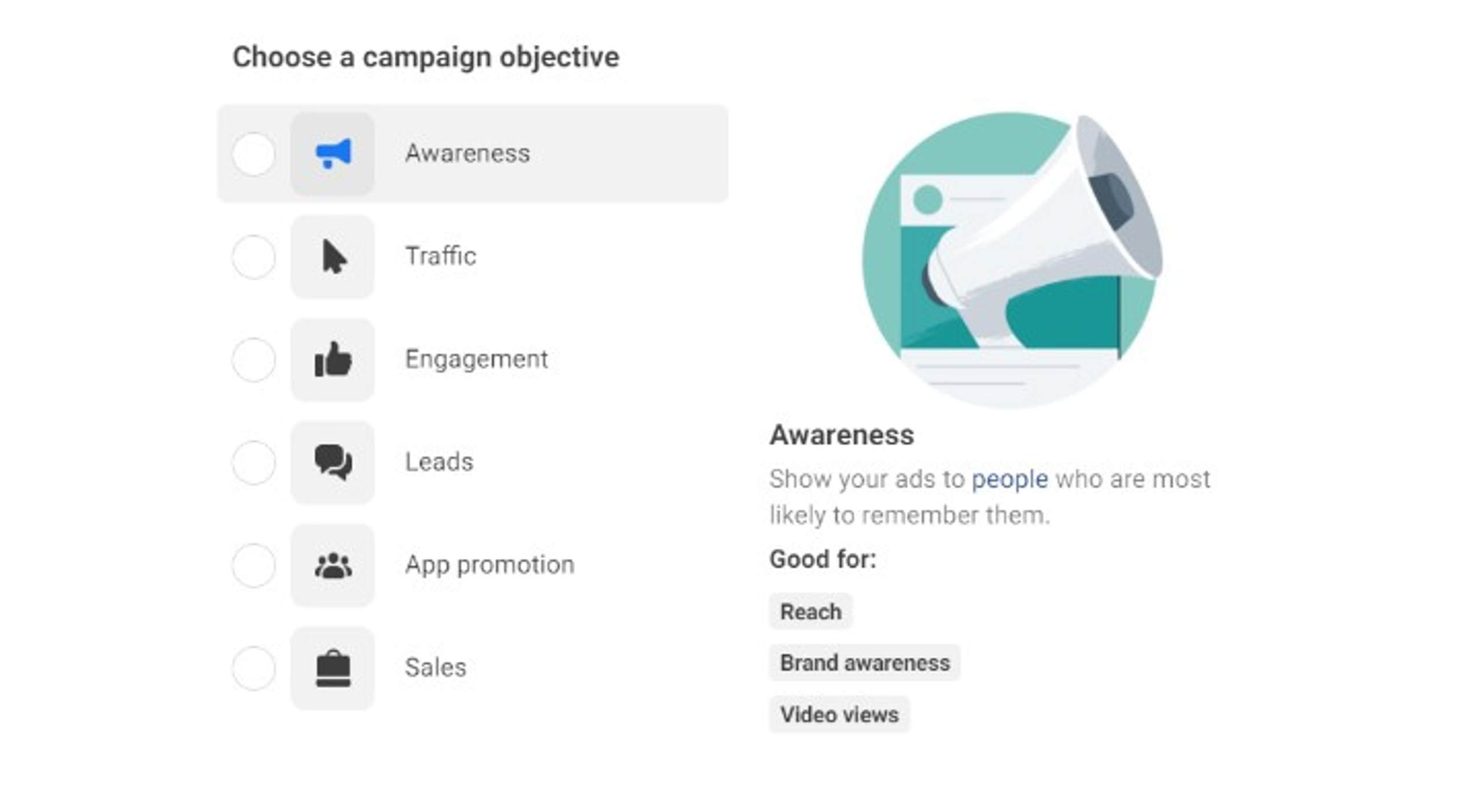
Awareness Objectives
There are two campaign objectives under the Awareness category. They are Brand Awareness and Reach.
Objective 1: Brand Awareness
The Brand Awareness campaign objective is one that keeps you memorable to your target audience.
This kind of Facebook ad helps you increase the awareness of your brand among people. If you are looking to explore a new target audience, this could also be an effective option to ignite an interest in your brand. Facebook typically shows these kinds of ads to people who tend to remember your brand by recalling your ad campaigns.

So how does Facebook know that they will remember?
Facebook analyses the behavior and interaction of users with ads. It also sets periodic polls for users to see if they remember seeing a Facebook ad.
Because the brand awareness objective is designed to draw impressions, Facebook gives you a data report that shows your "estimated data ad recall lift". This document gives you an estimate of how many people would remember your ad if you asked them two days after seeing it.
Your recall data is even more accurate when you take a brand lift study. Keep in mind that this study may also take a chunk out of your budget.
It is important to remember that you are not trying to break even with this kind of ad. You shouldn't expect users to come rushing onto your landing page or to get a huge bump in sales.
However, when these kinds of ads go out, you can rest assured that someone thought about your brand today, another will be interested tomorrow, and many others will remember your brand the day after.
As good as this sounds, objectives that increase brand awareness are only useful to big brands that have established themselves in the industry and are only trying to remain in the faces of their clients.
If you are just starting out as a business, then brand awareness is not the most effective option for you. Even when you seek to increase your brand awareness, there are more suitable options for you as a brand. We'll talk about them shortly.
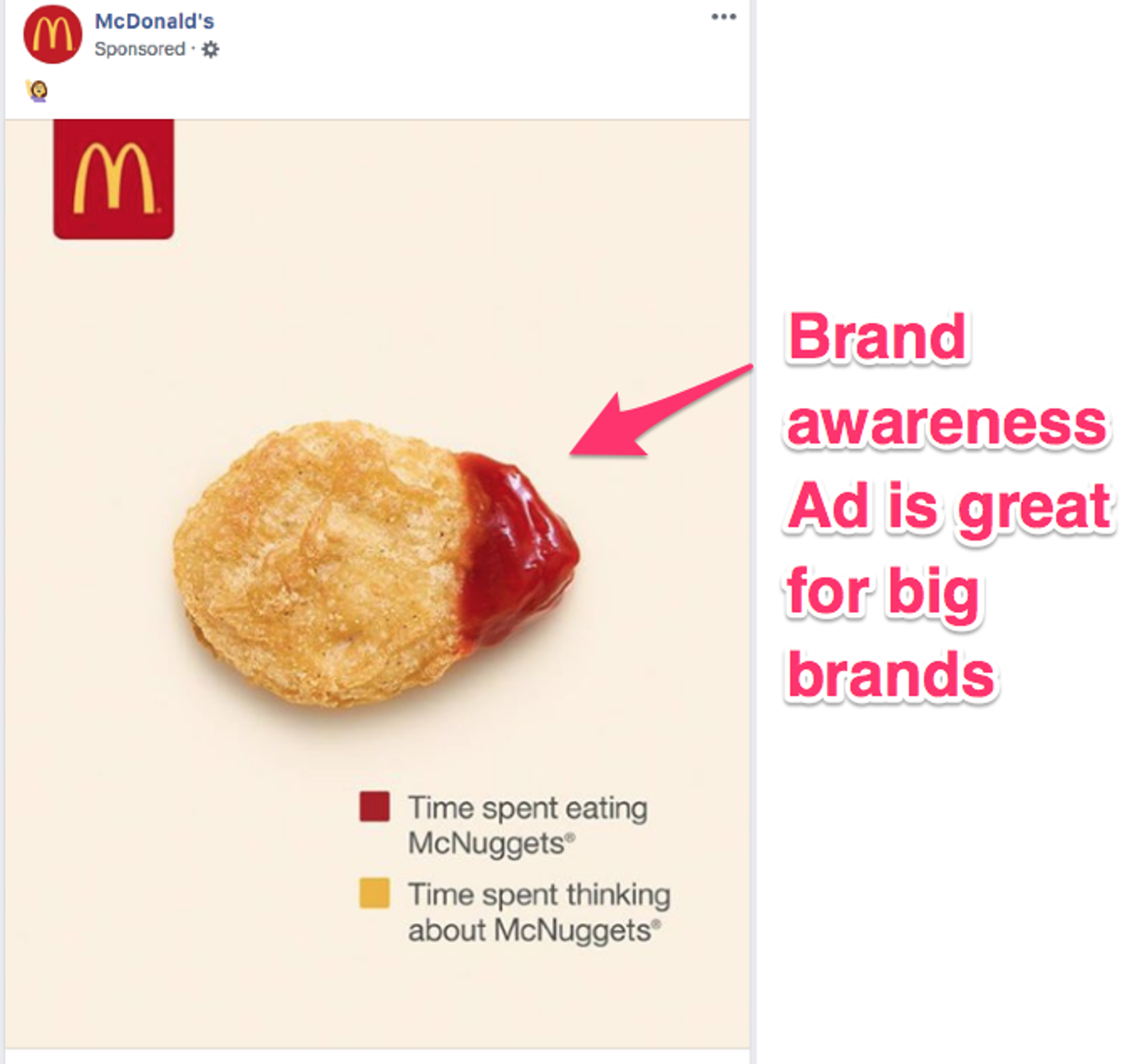
When to choose the “Brand awareness” objective?
- You want your target audience to recall your brand.
- You want to stand out among competitors.
- You want to easily come to the minds of your audience when they think about your industry.
- You want to pique the interest of a new audience that may be interested in your products.
Brand awareness ads come in form of images, videos, slideshows, and carousels.
Objective 2: Reach
Because Facebook has enough data to predict its user behavior, it sends your ads to people who would most likely respond in alignment with the objective you've set. For instance, when that objective is engagement, Facebook sends your ads to people who are more likely to like, comment or share. It is, however, important to note that Facebook tries to position all ads for engagement.
What has this got to do with the Reach objective?
The metric for positioning an ad with a reach objective is a bit different.
With a Reach Objective, Facebook ensures that your ad reaches every user that falls within your specified target audience, no matter if they are likely to interact with it or not.
When you set a reach objective, you can provide the geographical scope of your ad so that the ad does not spread beyond that scope.

You can also determine how often each user will see your ad while your budget stays the same.
Reach objectives are more concerned with a wide scope rather than the depth of the effect. So if you're running an ad with a reach objective, you should not be bothered about click-throughs, likes, or comments.
To be fair, some users skip ads after one second, no matter how excellent the ad is. So with reach, you are also paying for those who skip your ad the moment it comes on their screen. On the bright side, Reach gives you the maximum rate of impressions on a low budget.
The only indicator you can track on this Facebook ad is if it has reached every user within your location.
When to choose the “Reach” objective?
- When you are trying to pass information. For instance, you are trying to announce a concert or the date a movie is coming to the cinema.
Example Ad: The Conference You've Been Waiting For

- You are trying to create awareness of your brand in a specific location. For instance, you have just opened your new branch of lock services in a new suburb and you need to inform the residents, a reach objective can get the job done.
The Consideration Campaign Objectives
In the most generic form, Consideration objectives drive Facebook users to learn more about your brand and keep it within their consciousness. Consideration reviews may also be known as call-to-action objectives. This is because they tell users what you want them to do. The call to action in each campaign objective may differ, which also differentiates the target audience for each objective.
Consideration objectives are made up of low-intent actions since they do not directly lead to sales. As such, they might not be the best option if you are trying to convert leads.
Consideration campaigns include six objectives.
Objective 1: Traffic
The Traffic objectives are as true as they come, and they don't make any promises. Just as the name implies, traffic objective sends your target audience from your ad to any page that you link to the ad. Facebook achieves this by sending your ads to people whose Facebook behavior indicates that they will click on outbound links. This in turn drives traffic to your page as promised.
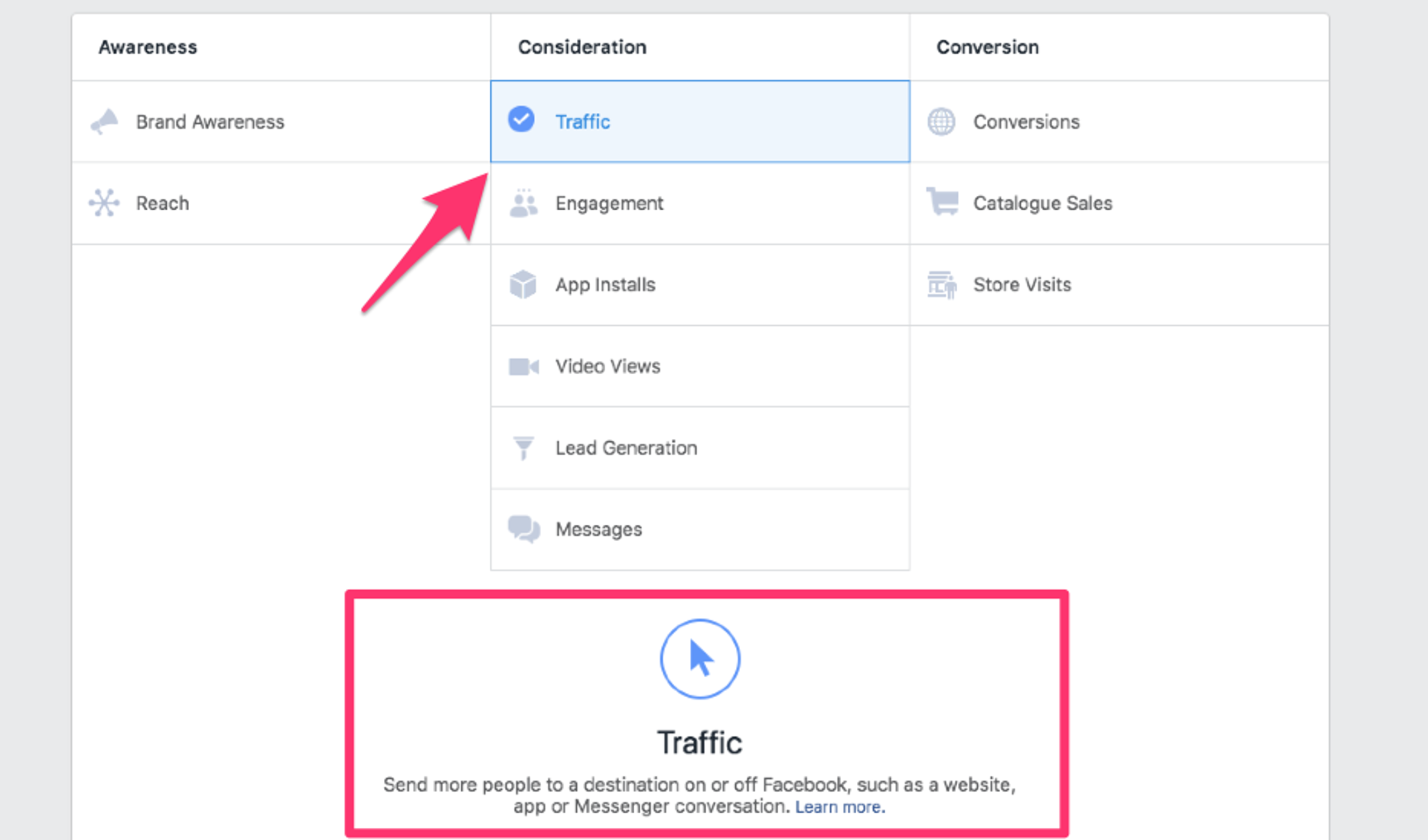
The interesting thing is that this is where the story ends. Once Facebook sees users off to your web page, it no longer owes you an explanation as to whether or not they have engaged your page, or if they have made a purchase. Even if the customer leaves the page right after clicking, the job is regarded as done.
Even in the report, you should not expect to see an analysis of actions that have taken place on your page since the report only analyzes clicks.
Traffic can be a good move for your page, but it may also increase your bounce rate and exit rate while the conversion rates and session duration remain on the same level.
However, if you're trying to attract people to your landing page, you can set the destination to landing page views in your settings. This will send your link to people who will go beyond clicking and actually wait for the website to open so they can view it. To run this optimization, you must ensure that your ad account is connected to the Facebook Pixel on your website.

When to choose the “Traffic” objective?
If you’re trying to sell, get registrations, or get your prospects to see a fantastic lead magnet, Traffic is not the way to go for a Facebook ad campaign objective.

Traffic is mostly used to draw attention to something that you want people to be aware of. If you run a lifestyle page or a gist blog, Traffic will work for your site. Traffic seems to be the best option for content creators that work with views on their videos, listens of their podcasts or publicity for artistic work. It could also work for a "Learn more about us" page. Technically, Traffic may also be some form of awareness.
Objective 2: Engagement
What is online content without engagement?
Even Facebook agrees enough to split engagement into three. When you run an ad with the objective of Engagement, you can either run a Post Engagement, Page Engagement, or Event Response.

Before we talk about this, we should examine Engagement as an umbrella.
Engagement helps you drive actions specifically within Facebook. The objective helps you drive more likes and shares. When you go for an Engagement objective, Facebook sends your ads to people who would most likely engage by sharing, liking, and commenting.
Engagement drives users to take action within Facebook. More specifically, this relates to likes, shares, and comments. Ads that have higher engagement tend to be trusted by the general public.
When you see a product review that has millions of views and thousands of likes, you tend to trust it more than a review that has hundreds of views and a few likes.
Even if you have no idea what the video is about, you become curious about the content when you notice that it has gathered thousands of views in such a short time.
When your posts have more likes and comments, other viewers tend to pay more attention to them.
Which are you more likely to respond to? A video with 15 likes, 0 comments, and 2 shares, or a video with 782 likes, 216 comments, and 70 shares?
You, just like everyone else will go for the latter.
Ad engagement also helps you build a wider reach organically. When people engage with your ads, the content becomes visible to their friends and contacts who may also like, share, and comment.
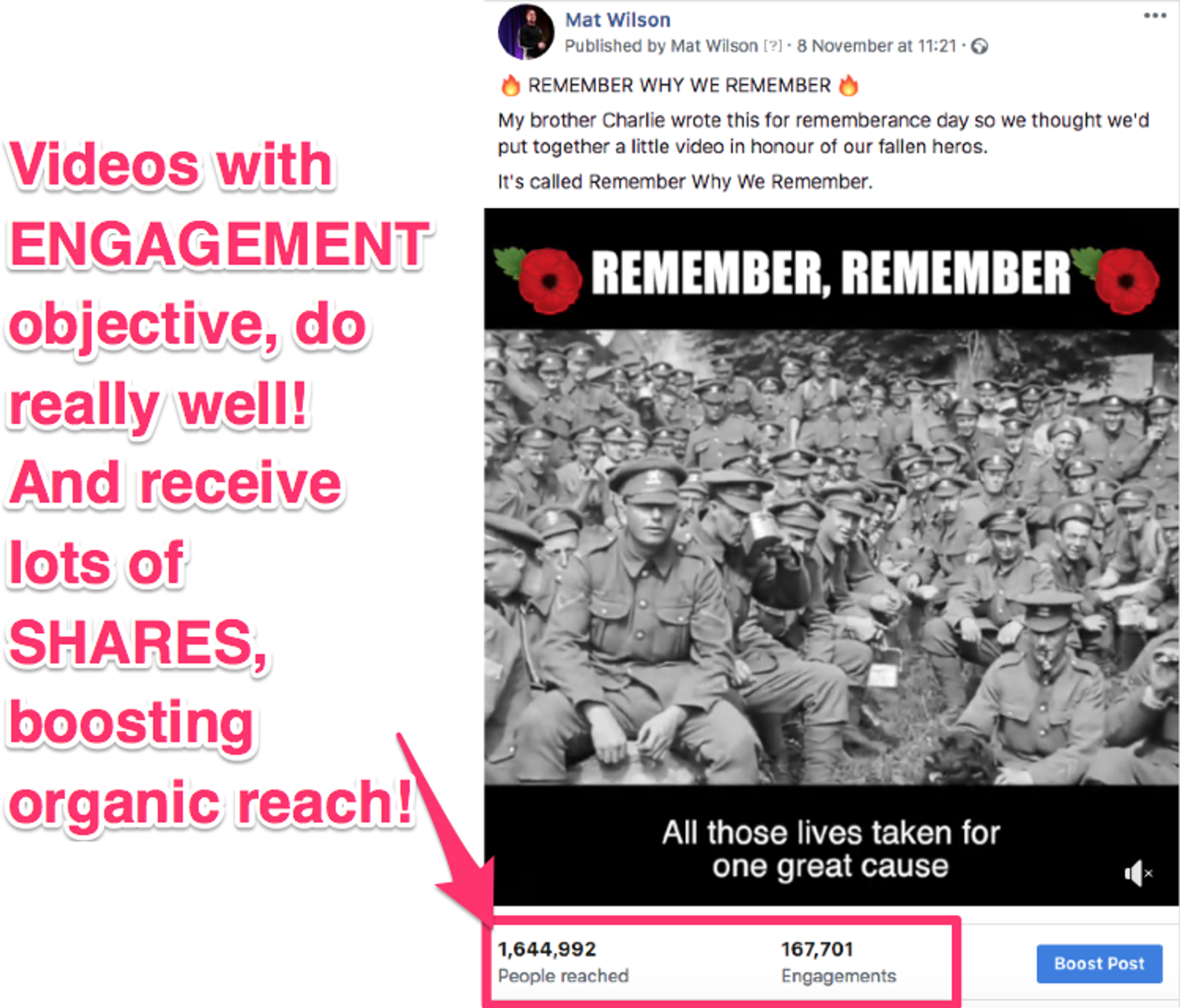
Engagement objectives may be used to drive three major forms of objectives.

When to choose the “Post Engagement” objective?
Post Engagement is your ticket to gaining credibility through social proof. With Post Engagement, you can target users who tend to react to ads.
Implementing the Post Engagement objective will target people who regularly engage with ads. This results in tons of likes, shares, and comments on your ad. Post Engagements also help you retarget your audience and expand it. When your posts have a lot of views and comments, the Facebook algorithm shows them to more people.
You can also convert the engagement to another post by copying the ID of the Facebook Ad. Engagement ads work when you plan to reach more people and improve awareness, you plan to create a visual post or reap the effects of social proof. You can run these ads as images, videos, or slideshows.

When to use the page engagement objective
If you are trying to build your following organically, or you're trying to reach wide, use this Facebook ad campaign objective.
When newcomers visit your pages, they tend to be more active when they see that others engage with your page. They can trust your credibility. Page engagement also creates a pop culture feel about your page. It gives the vibe that whoever does not engage with your page is missing out on something interesting.
If your brand thrives on social media marketing, you should pay heavy attention to running page engagement campaigns. If you can budget five dollars daily, you'll record the difference over a long period of time. Page engagement works best for social proof, brand awareness, and wider post reach.
When to choose Events engagement objective
If you’re trying to get people to your art exhibition, fundraiser, or concert, Event Engagement seems like the perfect Facebook ad campaign objective for you…
Well, it is not.

Event Responses tend to draw attention to an event occurring on Facebook. As such, the objective is targeted at getting people to know about that event. For example, Event Engagement could be used to invite someone to a Facebook webinar or event.
This objective also encourages engagement within Facebook, in essence asking somebody among your target audience to accept an invitation to an event on a Facebook page.
As straightforward as this sounds, you may still open your page to a low turnout on the day of the event. This is because event engagement tends to be surface-level like traffic engagements. The mere fact that someone has clicked Yes to your invitation does not mean this person will actually attend your event.
So what should you do?
Use ads that are better designed to convert leads.
Objective 3: App Installs
If you have developed an app that you want people to know about, then the App Installs is the one for you. This is one of the most specific forms of ad objectives on the list. They tell you what exactly they can do, while you tell them how you can help.

As it has been established, Facebook targets your campaign at users who have a history of clicking on app install links and downloading those apps from the app store. As is expected, ads like this are also linked directly to an app store.

When to choose the “App Installs” objective?
The App installs campaign objective is your go-to objective when you need more people to install an app that you have built. This helps you with getting more credibility on the app store by earning more downloads, or if you just want to earn more money from the app itself.
Objective 4: Video views
Video views objectives are also as straightforward as they come. These objectives promise you more video views and nothing more. So if you are trying to drive sales through a video, you may realize that people view your videos but the visibility is not translating to lead conversion.

When to choose the “Video Views” objective?
So when you research more about Video Views ads, you have to turn the ambitions down for a bit. The effect of using this objective is often identical to running a Reach campaign.
The objective is good to drive awareness of your brand through viewership of your video ads.
Objective 5: Lead Generation

Lead generation ads help you generate leads from your target audience without necessarily taking them out of Facebook. The way it works is that you add your lead magnet, which is mostly some freebie, in exchange for the user details. The user fills in the details and gets their freebie right there on Facebook.
When to Choose the Leads Generation Objective

The Lead generation objective is best for reaching clients who already know about your business or are in the consideration stage of the funnel. While they do not automatically convert to sales, lead generation objectives can help bud a subscription or marketing list for retargeting.
Objective 6: Messages

The Message objective helps you interact with your customer on a deeper level. Message objectives are associated with ads that let your audience message you on Facebook. In most cases, they reach out to enquire about the service and ask for help.
While it is a good way to bond with your customers, it may not be effective if you don't respond swiftly.
When to choose the Messages objective?
Messages is an effective objective for people who want higher returns from their marketing list. You can build an entire marketing funnel or generate leads by interacting with your customers through Message ads. With a 50% CTR and 99% open rate, Messages objective is an amazing choice for building leads.
Conversions Facebook Campaign Objectives
This is where the action really happens. The conversion campaigns get people to buy your products or engage with your services.
Objective 1: Conversions

The conversion objective brings your target audience to the most important part of your funnel, which is sales itself. With your Facebook Pixel on your website, Facebook gets to monitor your page to figure out who is likely to buy your products and send those ads to them. Conversions objective can also work for registrations, invitations, and other marketing purposes that aim to cause your target audience to take action.
When to choose the “Conversions” objective?
Conversion is most easily achieved when you have gone through the brand awareness and engagement part. That way you don't have to convert cold traffic.
This objective is ideal for testing landing pages and making sales.
Objective 2: Catalog Sales
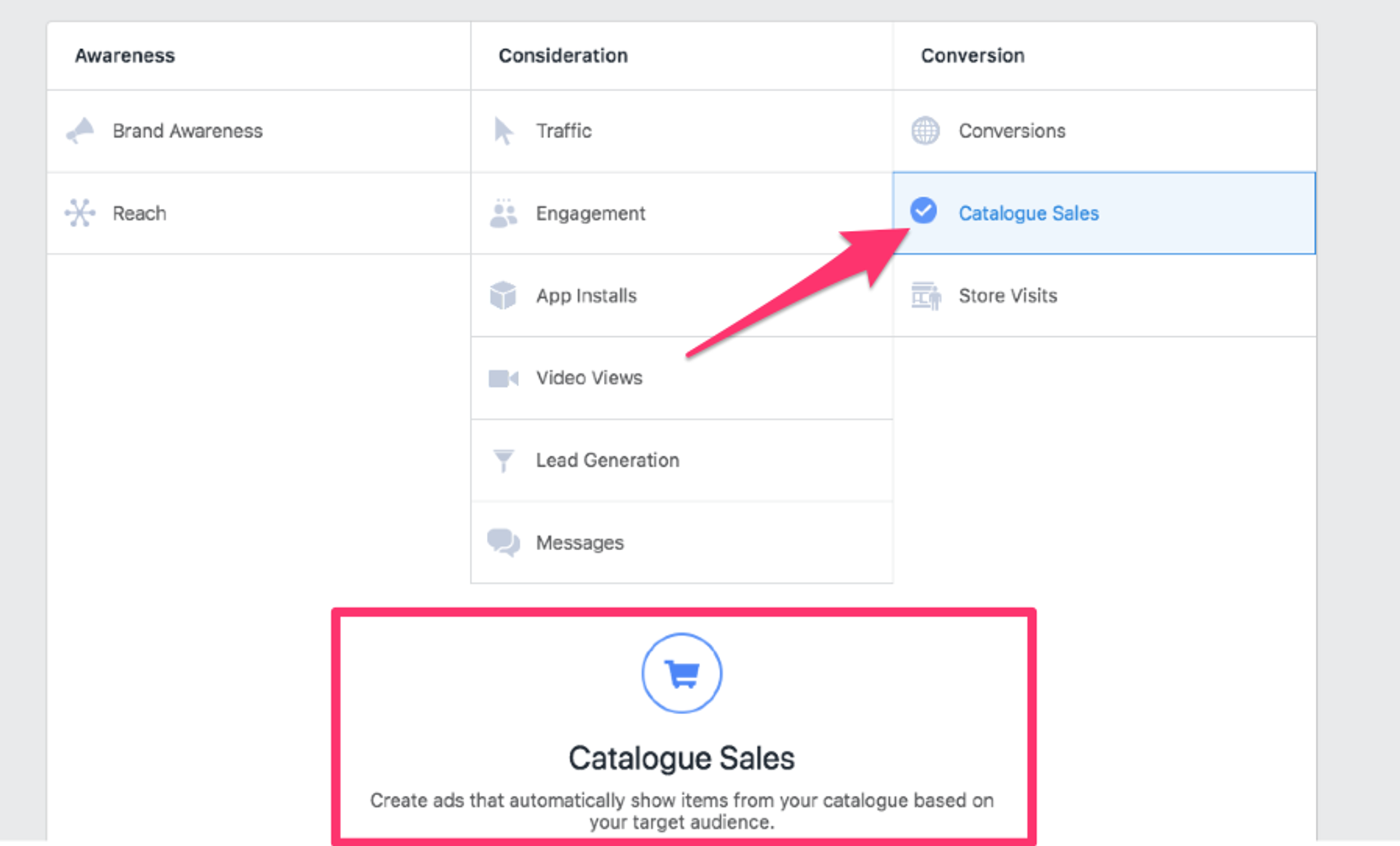
Facebook knows what you sell and it knows those who are likely to buy it. It shows the products in your Catalog to these users so they can purchase products from you. The aim of the catalog sales objective is to improve your sales. All you have to do is integrate your catalog so Facebook can pull your products when needed.
When to choose the “Product catalog sales” objective?
Product catalog sales objective is ideal for large e-commerce stores that are looking to expand their customer base or brands that are known among the target audience. It also works best for sales of visible and tangible products.
Objective 3: Store visits

The store traffic objective aims to drive traffic to your physical store. When all your business locations are saved on Facebook Business Manager, all users whose locations indicate that they are around you get your ads. This in turn increases the number of customers that visit your physical store.
Keep in mind that it is necessary to ad your business's address in Business Manager to use this objective.
When to choose the “Store visits” objective
Store visits do not necessarily generate sales, but it is good for brand awareness, especially for brick-and-mortar stores.
Now that you have an understanding of all Facebook campaign objectives, you can be more deliberate about running campaigns and getting the results you want.
